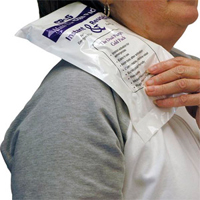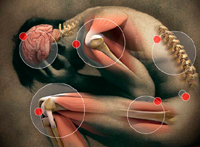Should I use ice or heat for my back pain?
That’s probably the most common question asked about treating back pain. The best way to answer it, I have found, is to explain exactly what ice and heat do and why they help relieve pain. Once you understand the mechanism behind these treatments, you’ll be more likely to use them when your own back pain flares up.
The Pain-Spasm Cycle
 Let’s say you have sciatica. Your piriformis muscle goes into spasm. Your body reacts to this “injury” by sending more white blood cells to the injury site to fight the problem. That means fewer red blood cells go there, which means the injured area is getting less oxygen and nutrients, and waste products aren’t being carried away. This causes what’s called Secondary Hypoxic Injury. The site is actually injured even more by lack of oxygen (hypoxia).
Let’s say you have sciatica. Your piriformis muscle goes into spasm. Your body reacts to this “injury” by sending more white blood cells to the injury site to fight the problem. That means fewer red blood cells go there, which means the injured area is getting less oxygen and nutrients, and waste products aren’t being carried away. This causes what’s called Secondary Hypoxic Injury. The site is actually injured even more by lack of oxygen (hypoxia).
It may also put the muscle into a pain-spasm cycle. The injury triggers nerves to send signals to the brain, which interprets it as pain. This pain tells the brain to send a signal back to the injured area, which contracts the muscles to close off blood supply to prevent swelling. But this lack of blood supply actually leads to more pain, more swelling and more spasms.
To review: The initial spasm causes pain and swelling, which leads to more injury and further spasms. More pain, more spasms, more pain, more spasms—a vicious cycle. Without treatment, this cycle can last for years. The only way to begin healing the muscle is to break this cycle. That’s where ice and heat come into play.
When You Are Ready to Apply Heat….
Click this link below to learn more about Far Infrared Heating Pads:
Back Pain Heating Pads
Breaking the Pain Cycle
Heat and ice both do same thing—they shock the body into breaking the pain-spasm cycle. Heat causes the body to circulate more blood to the area in order to cool it down. That brings more oxygen and nutrients, and removes waste products, which help heal the tissue. Cold is similar—the body sends more blood to the area to warm it up and promote healing.
Heat or cold also shut down the nerves that fire the pain signals—heat relaxes them, cold numbs them. When the brain doesn’t get the pain signals, it doesn’t act to contract muscles and constrict blood flow. After applying heat or cold consistently and continually for a certain period of time, the pain-spasm cycle is broken. Then, real healing can begin.
Ice or heat, Which Is Best?
If both heat and ice do the same thing, which is better to treat back pain? There are really no hard and fast rules, but I typically have my patients do the following:
-
- When an injury first occurs, use ice first. This is true whether the injury is acute (caused by some trauma like lifting something heavy or sitting too long) or subacute (a flare-up of a chronic condition, like sciatica). It’s also important to use ice fast. You need to get ice to the injury within 5 minutes to get the best effect. If you’re not at home and don’t have ice handy, head to the 7-11 and buy a bag of ice. Begin treatment immediately. Apply ice for the first 48-72 hours. Use it for 20 minutes, then take it off for 20. Repeat as often as you can.
-
- After 48-72 hours, when you feel the swelling has gown down and the pain-spasm cycle is broken, you can begin stretching the injured muscle with the appropriate exercises. At this point, choosing ice or heat is really up to you. Most people like heat before they exercise and ice after. Either way, you’re getting red blood cells to the area to promote healthy healing.
-
- For a really advanced treatment plan, I recommend a contrast bath. Try 20 minutes of heat followed immediately by 20 minutes of ice. Repeat three times. The contrast really shocks the body and gets it out of the pain-spasm cycle.
Our Top Recommended Heating Pads:
Far Infrared Heating Pads:

Ordinary heating pads are slow to heat and do no more than warm your skin. With penetration of just 2-3mm (about the thickness of your skin), they simply can’t pierce far enough to warm deep muscle, tissue and organs.
As soon as you turn the heating pad off, any small benefit you might have gotten from the heat instantly disappears. Far infrared heat, on the other hand, heats fast and penetrates so deep, you’ll feel the comfort and pain relief last up to six hours (depending on how long you soak in the heat).
Click this link below to learn more: Back Pain Heating Pads
What to use and how to apply ice or heat:
In this section, I want to review the various way you can apply ice or heat and the devices that are available today.
Let’s start with ice. There are chemical ice packs, which I personally would not recommend because they can get too cold and burn the tissue. There is the good old bag of frozen vegetables–not great, plus it is a bit of a waste. There are pain creams that use Menthol to give a cold sensation to the skin and work great. They can be applied ASAP.
The best application of ice I have found is to use a Zip-loc bag with crushed ice in a bit of water, Remove all of the air from the bag and then zip it closed. It is best to also put a wet paper towel on your skin over the affected area, then apply the ice bag.
To further improve the effectiveness of ice, first rest the area, then use a wrap over the ice pack to improve the contact with the skin and to compress the area to minimize the swelling. If the area can be elevated, please try to elevate it to allow the area to drain at the same time.
Now let’s talk heat, my favorite form of therapy. There are heating lamps, heating pads, hot tubs, hot showers, pain creams with cayenne pepper and even ultrasound, which is a form of heat.
I know what you are going to ask which works the best. Personally, I love the hot tub. Unfortunately I do not own one and going to a community hot tub is like taking a dip in a cesspool (you can look up the definition).
With that said, as technology advances and becomes cheaper for the masses, far-infrared heat is by far at the top of my list now. Far-infrared heat transforms safe light energy into safe heat energy, at a frequency that penetrates the body up to three inches with an even distribution and prolonged thermal effects.
I have identified 28 back pain-related conditions and 15 general medical conditions for which far-infrared heat can help promote better health and wellbeing.
The Path to Pain Relief
Remember that heat and ice are not the solution to long-term pain relief. They are the paths to the solution. The goal of both ice and heat is to break the pain-spasm cycle and allow you to do the stretching exercises that build muscle strength and flexibility. That’s what brings prolonged pain relief. And that’s the ultimate goal, isn’t it?
 Silence Stubborn Pain and
Silence Stubborn Pain and
Rapidly Speed Up Healing…
While this ancient healing method works magic on your body! Click here to learn more about this time-tested treatment
Written By: Updated: May 13,2011


